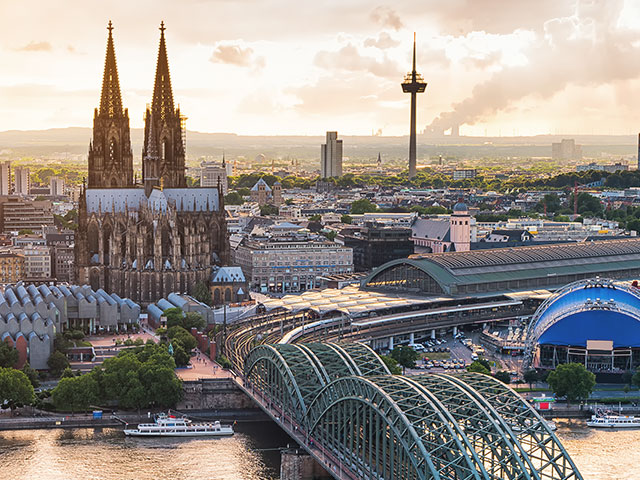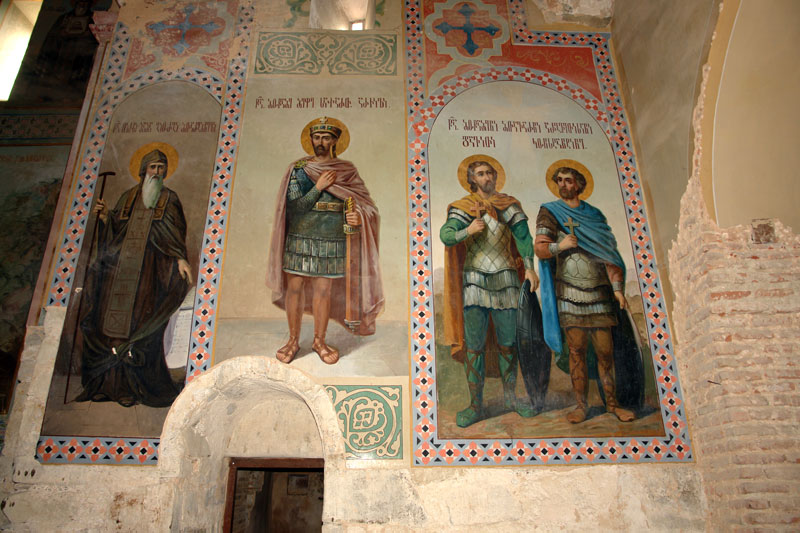._003.jpg/1280px-Algeti_National_Park_(13_October_2007)._003.jpg) Algeti National Park (also know as ალგეთის ეროვნული პარკი in Georgian) is a 157.6 km²
park situated in Algeti Valley in Georgia, in the north of the region of Kvemo Kartli. It was established in 1965 (established as a national park in 2007) and to protect the easternmost limits of the Caucasian spruce and Nordmann fir. Next to it are located the woody southern slopes of the eastern Trialeti Range
Algeti National Park (also know as ალგეთის ეროვნული პარკი in Georgian) is a 157.6 km²
park situated in Algeti Valley in Georgia, in the north of the region of Kvemo Kartli. It was established in 1965 (established as a national park in 2007) and to protect the easternmost limits of the Caucasian spruce and Nordmann fir. Next to it are located the woody southern slopes of the eastern Trialeti Range
How do I arrive to Algeti National Park?
Algeti National Park isn't quite well communicated with other Georgian towns and cities. - Bus: there are marshrutkas departing from Tbilisi to Manglisi.
- Car: the main entrance to Algeti National Park is via Manglisi, that can be reached from places such as Tsalka (aprox. 40 minutes), Marneuli and Tbilisi (aprox. 1 hour 10 minutes), Mtskheta (aprox. 1 hour 25 minutes), Rustavi (aprox. 1 hour 40 minutes) or Ninotsminda (aprox. 1 hour 50 minutes).
Once
in the Park the best ways to move around the park are the car or simply hiking.
History
Before the creation of the reserve, the territory of the modern Algeti National Park belonged to the Manglissky forestry of the Tetri-Tskarsky forestry enterprise. Inspection of its massifs revealed valuable stands of Eastern spruce and Caucasian fir. The eastern border of the areas of these tree species runs through the Lesser Caucasus, therefore these plantations were of scientific value. To prevent their logging, in April 1965, this territory was declared a state nature reserve. Its area was 6400 hectares, but soon it was reduced to 6000 hectares [2]. From the first years of the existence of this protected area, difficulties arose in observing the strict conservation regime. They were due to the significant intersection of the protected zone with agricultural land, as well as, to a certain extent, the proximity to the boundaries of the reserve of tourist sites. Therefore, in 2007, a compromise decision was made: the status of the Algeti Reserve was downgraded to a national park, which made it possible to open access to tourist attractions for organized tourists and reduce the number of unauthorized visits.
What can I visit in Algeti National Park?
Algeti National Park is a unknown destination and not touristic at all. Therefore it can be a nice idea to breath some fresh air and enjoy unspoilt nature. In the following lines it will be explained what to do in the park according to
the town or village where they are or the nearest one:
-
- There are some nice trails departing from Manglisi Cathedral, getting deeper into Algeti National Park. The main ones are Royal Ridge Trail (14.7 km) and Choliani-Kldekari-Manglisi Trail (19.4 km). This last one crosses Torghva Canyon till it reaches Kldekari. Here are located the Ruins of Kldekari Fortress, remains of a castle of the 9th century that was built by Duke of Kldekari Liparit I Baghvashi, placed in an important crossroads. It was attacked and conquered in the wars between Georgian kings and some nobles. Close to it is situated Mount Kldekari (2,000 m high) too, the highest point in the national park.
- Going south, there's another part of the planned national park, located around Algeti Reservoir.
This artificial lake where river Algeti flows, where it's planned to
build a 1.1 MW hydroelectric station. Next to it there's a nice forest, Baxcho Wood, or the Ruins of Amlivi Complex
(place that has a church, a bell tower and several farm buildings from
the 17th century, and a 15th-16th century fortress). Here it's possible
to discover Birtvisi Canyon, enjoyin monumental cliffs,
small waterfalls, rocky tunnels that make a beautiful and mystical
environment. In the canyon there's Birtvisi Fortress, a
ruined fortress within limestone cliffs in the gorge of Algeti river. It
was first mentioned in the 11th century and in medieval Georgia, it had
a reputation of an impregnable stronghold. After the partition of the
Kingdom of Georgia, Birtvisi was within the borders of the Kingdom of
Kartli (in possession of the princes Baratashvili).
.jpg/1280px-Manglisi's_Sioni_(2).jpg) |
Manglisi Cathedral
|
 |
| Torghva Canyon |
 |
Frescoes of Betania Monastery
|
In the way from Tbilisi to Algeti National Park there are some places that are worth a visit. One of the highlights is Betania Monastery,
a monastery whose construction took place in the 11th-12th centuries as
a familial abbey of the House of Orbeli, considered a remarkable piece
of architecture of the Georgian Golden Age. The monastery is notable for
its wall paintings (damaged murals but also one of the high points of
medieval Georgian wall painting), including representations of
contemporary Georgian monarchs like George III, Queen Tamar or George
IV. Betania remained the only operating Georgian monastery in the Soviet
Union until 1963 (it opened again in 1978).  |
Fragments of frescoes in Ikvi Church
|
the other side of the border, in the region of Shida Kartli, it's the area known as Trialeti, an ethnographic region around Trialeti Range. Part of is what was known as Trialeti Ossetia, an area of settlement of Ossetians until the early 1990s. On the western part it can be found Rkovi Monastery, a monastic complex first built in the 7th century, rebuilt in the 13th-14th century and in the 17th-18th century too (because it was destroyed in 1400 after Tamerlane's raids). Next to it are located some other religious highlights such as Ikvi Georgian Orthodox Church (11th century cross-in-square church known for its elaborate decorative external stone carvings and the 12th-13th high-quality century frescoes) or St. Giorgi Georgian Orthodox Church in Saorbis (ruins of a church built in 1152 that keeps some very nice stone carvings and fragments of frescoes). .jpg)
|
Kvatakhevi Monastery
|
On the eastern part of this reserve, it's located Kvatakhevi Monastery,
a monastic complex that dates back to the 12th-13th century. Its
architecture resembles the monasteries of Betania, Pitareti and
Timotesubani, reflecting a contemporary canon of a Georgian domed church
architecture. It was a literary center where several manuscripts were
copied and also possessed a treasure with many artifacts of medieval
Georgian jewelry (on display at the Moscow State Historical Museum).
Very close to the monastery, on river Kavtura, it can be enjoyed the
beautiful Tavkavta Waterfall. Continuing by the river it can also be found Lavriskhevi Georgian Orthodox Church (10th century cross-in-square church that had frescoes, a wooden floor and an iconostasis added in the 19th century) and Magalaant Church Complex
(14th century complex that was owned by the Maghaladze, a noble family
from Imereti that were elevated to the category of dukes under king
Erekle I).
.jpg) |
Views of Tsalka
|
In the northwestern corner of the region of Kvemo Kartli (one of the regions with most ethnic diversity in Georgia) it can be found Tsalka (წალკა in Georgian, Τσάλκα in Greek, Ծալկա in Armenian), a 2,326 inhabitants small town that used to have the largest communities of Caucasian Greeks (the only area in the USSR where the Greek language was taught in schools because more than 90% of the population where Greeks). Now their numbers have considerably decreased due to emigration to Greece. One of the witnesses of this Greek presence is Tsalka Greek Orthodox Church, a three-aisled basilica with origin in the 6th century. The town has a significant Armenian population too. Next to the town it can be visited Dashbashi Canyon, a part of Khrami gorge created by the erosion of the volcanic plateau. Its main highlights are the cascading waterfalls, specially Dashbashi Waterfall becuase of its exotic emerald colour.  |
Dashbashi Waterfall in Dashbashi Canyon
|
Other natural sights close to the town are Tsalka Reservoir, the largest reservoir in all Georgia; or Lake Bareti, a beautiful blue lake with open spaces that creates wonderful scenery. This area has some other monuments that can be interesting to visit. Some of them are St. Giorgi Georgian Orthodox Church in Dashbashi (domed church from the 10th-11th century comissioned by the eristavi Rati with some inscriptions), Ghvtismshoblis Church in Dashbashi (ruins of an Armenian church from the 19th century, only preserving its apse) or St. Giorgi Georgian Orthodox Church of Tejisi (medieval hall church with a megalithic fence). Avranlo Megalithic Fortress, a fortress that dates back to the first millennium BC, is also a good sight of this area.
Where can I eat in Algeti National Park?
There
aren't many places to eat within Algeti National Park and it's
probably a good idea to eat in the nearest large town.
._003.jpg/1280px-Algeti_National_Park_(13_October_2007)._003.jpg) Algeti National Park (also know as ალგეთის ეროვნული პარკი in Georgian) is a 157.6 km²
park situated in Algeti Valley in Georgia, in the north of the region of Kvemo Kartli. It was established in 1965 (established as a national park in 2007) and to protect the easternmost limits of the Caucasian spruce and Nordmann fir. Next to it are located the woody southern slopes of the eastern Trialeti Range
Algeti National Park (also know as ალგეთის ეროვნული პარკი in Georgian) is a 157.6 km²
park situated in Algeti Valley in Georgia, in the north of the region of Kvemo Kartli. It was established in 1965 (established as a national park in 2007) and to protect the easternmost limits of the Caucasian spruce and Nordmann fir. Next to it are located the woody southern slopes of the eastern Trialeti Range.jpg/1280px-Manglisi's_Sioni_(2).jpg)



.jpg)









 12:41
12:41
 Banknotemaniac
Banknotemaniac
.jpg)
 Posted in:
Posted in: 


.jpg/1024px-2016_Mccheta%2C_Klasztor_Samtawro%2C_Cerkiew_Przemienienia_Pa%C5%84skiego_(07).jpg)


.jpg/1280px-Armazi_ruins_-1_(Photo_A._Muhranoff%2C_2010).jpg)

.jpg/1280px-Mukhranbatoni_Palace_(1).jpg)

-2.jpg/800px-Ertatsminda_church_(Photo_A._Muhranoff)-2.jpg)
.jpg/1280px-Martkofi_Monastery_(24).jpg)
.jpg/1280px-Martkofi_Monastery_(8).jpg)

.jpg/1280px-Tsilkani_church_(1).jpg)

